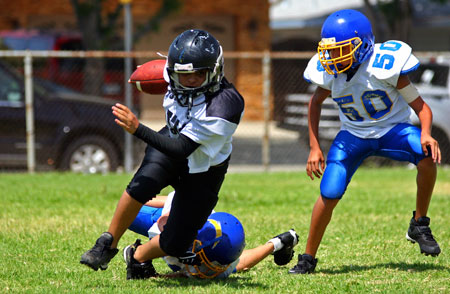
Everyone from the National Football League to local school districts and youth sports leagues is concerned about the long term effects of concussions. The proper evaluation and management of concussions is of great importance to us at Woodcreek Pediatrics - Mary Bridge Children's.
All of Woodcreek Pediatrics - Mary Bridge Children's providers are certified in Concussion Management. Our documented Concussion Management Policy is based on the latest research and standards of care as documented by the American Academy of Pediatrics and the American Medical Society for Sports Medicine. Woodcreek Pediatrics - Mary Bridge Children's is fully prepared to provide up to date treatment based on the latest standards of care and medical management for this challenging diagnosis.
All of Woodcreek Pediatrics - Mary Bridge Children's providers are certified in Concussion Management. Our documented Concussion Management Policy is based on the latest research and standards of care as documented by the American Academy of Pediatrics and the American Medical Society for Sports Medicine. Woodcreek Pediatrics - Mary Bridge Children's is fully prepared to provide up to date treatment based on the latest standards of care and medical management for this challenging diagnosis.
What is a concussion?
At its simplest, a concussion is an injury to the brain caused by a blow, fall or hard hit to the head or body which causes the brain to impact the skull. Concussions are not bruises to the brain, but rather traumas – which is why they are sometimes labeled as traumatic brain injuries. Concussions can occur in sports, car accidents, falls and injuries on the job.
While signs and symptoms vary with each concussion, only one symptom needs to be observed for a concussion to be present. Common symptoms may include: headaches, nausea/vomiting, dizziness, blurred vision, sensitivity to light, “foggy” feeling, low energy, drowsiness, confusion, irritability or balance problems.
At its simplest, a concussion is an injury to the brain caused by a blow, fall or hard hit to the head or body which causes the brain to impact the skull. Concussions are not bruises to the brain, but rather traumas – which is why they are sometimes labeled as traumatic brain injuries. Concussions can occur in sports, car accidents, falls and injuries on the job.
While signs and symptoms vary with each concussion, only one symptom needs to be observed for a concussion to be present. Common symptoms may include: headaches, nausea/vomiting, dizziness, blurred vision, sensitivity to light, “foggy” feeling, low energy, drowsiness, confusion, irritability or balance problems.
How are concussions managed?
When an individual is identified as having sustained a concussion by a coach or medical professional, they are typically pulled from sports or asked to refrain from participating in physical activities until cleared by a trained professional in concussion evaluation and management. The Zackery Lystedt Law requires medical clearance of youth athletes suspected of sustaining a concussion prior to returning to the game, practice or training in Washington State.
People with suspected concussions are medically evaluated using a variety of specialized assessment tools. They are monitored to ensure symptoms are not progressing and they are allowed to rest and recover. In the case of student athletes, return to play on the same day that they presented with symptoms is prohibited. Once symptoms have resolved, exertion testing is performed prior to being cleared for activity
When an individual is identified as having sustained a concussion by a coach or medical professional, they are typically pulled from sports or asked to refrain from participating in physical activities until cleared by a trained professional in concussion evaluation and management. The Zackery Lystedt Law requires medical clearance of youth athletes suspected of sustaining a concussion prior to returning to the game, practice or training in Washington State.
People with suspected concussions are medically evaluated using a variety of specialized assessment tools. They are monitored to ensure symptoms are not progressing and they are allowed to rest and recover. In the case of student athletes, return to play on the same day that they presented with symptoms is prohibited. Once symptoms have resolved, exertion testing is performed prior to being cleared for activity

SCAT 5 and Child SCAT Assessments
The Sport Concussion Assessment Tool 5 (SCAT5) is a standardized tool used for evaluating injured athletes for concussion and can be used with children 13 years and older. This tool is designed for use by qualified first responder or medical professional. The SCAT5 does not independently determine the diagnosis of a concussion and it cannot determine the injured athlete's recovery or return to play status. Only a qualified medical professional, after a complete examination, is able to comment about the injury and recovery status. It is important to note that any athlete or individual may have a concussion, even is the SCAT5 is "normal"
For those younger than 13, the Child SCAT5 is available.
The Sport Concussion Assessment Tool 5 (SCAT5) is a standardized tool used for evaluating injured athletes for concussion and can be used with children 13 years and older. This tool is designed for use by qualified first responder or medical professional. The SCAT5 does not independently determine the diagnosis of a concussion and it cannot determine the injured athlete's recovery or return to play status. Only a qualified medical professional, after a complete examination, is able to comment about the injury and recovery status. It is important to note that any athlete or individual may have a concussion, even is the SCAT5 is "normal"
For those younger than 13, the Child SCAT5 is available.
After a concussion
When a patient arrives at Woodcreek Pediatrics - Mary Bridge Children's with concussion symptoms, our pediatric and urgent care providers will review previous health history and compare the current presentation with any baseline measurements that may have been documented. Comprehensive medical management will be performed and recommendations for further evaluation and plan of care will be addressed. The provider will determine if there is a need for physical and/or cognitive rest and will provide the required recommendations; included in this are recommendations for school or work accommodations.
Return to activity
Patients who wish to return to athletics are commonly referred to a specialist for Return to Activity Testing. A Graduated Return to Activity Program takes the patient through a stepwise progression of exertion to determine when it is safe to return to sports or routine activities. Commonly, Woodcreek will refer the concussed patient to a specialist to manage the Graduated Return to Activity protocol.
What should you do if you suspect a concussion?
Seek immediate medical attention such as going to the Emergency Department or calling 911, seek advice from your primary care provider or book an urgent care appointment in one of Mary Bridge Children's Urgent Care Clinics. Don’t leave the injured person alone and monitor them for changes in their symptoms which will be valuable to the medical professionals during their evaluation.
When a patient arrives at Woodcreek Pediatrics - Mary Bridge Children's with concussion symptoms, our pediatric and urgent care providers will review previous health history and compare the current presentation with any baseline measurements that may have been documented. Comprehensive medical management will be performed and recommendations for further evaluation and plan of care will be addressed. The provider will determine if there is a need for physical and/or cognitive rest and will provide the required recommendations; included in this are recommendations for school or work accommodations.
Return to activity
Patients who wish to return to athletics are commonly referred to a specialist for Return to Activity Testing. A Graduated Return to Activity Program takes the patient through a stepwise progression of exertion to determine when it is safe to return to sports or routine activities. Commonly, Woodcreek will refer the concussed patient to a specialist to manage the Graduated Return to Activity protocol.
What should you do if you suspect a concussion?
Seek immediate medical attention such as going to the Emergency Department or calling 911, seek advice from your primary care provider or book an urgent care appointment in one of Mary Bridge Children's Urgent Care Clinics. Don’t leave the injured person alone and monitor them for changes in their symptoms which will be valuable to the medical professionals during their evaluation.
